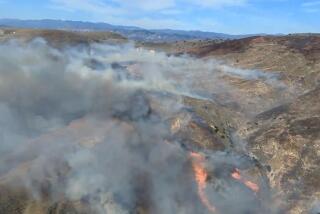Shift in weather aids fire fight
Calmer winds Tuesday kept the largest of two San Fernando Valley wildfires from making a run toward the sea, averting a disaster scenario that has played out regularly over recent decades.
The blazes, which have claimed two lives, destroyed 49 structures and burned 18,000 acres, heralded the start of Southern California’s Santa Ana season, when desert winds fan the most ferocious fires. By some measures, the region got off lightly.
“We were very, very fortunate we haven’t had the damage you’d expect,” said Mayor Antonio Villaraigosa.
The Sesnon fire, which started Monday in Porter Ranch, grew to 13,200 acres overnight. Light winds allowed firefighters to make headway Tuesday in cutting containment lines on the fire’s eastern flank.
The Santa Ana winds are expected to dissipate today, allowing even more aggressive fire-suppression tactics. Although the turn of weather was heartening, it was tempered by the knowledge that as Santa Ana fires go, these blazes were small and the winds that drove them relatively moderate.
The path the fires sought through the network of canyons ringing the Valley is a historic and predictable fire funnel, channeling flame to areas that have burned time and again. And the Santa Anas that drive the flames strike regularly through the fall.
“This was a preview of coming attractions,” said William Patzert, a climatologist at Jet Propulsion Laboratory in La Canada Flintridge. “Now we’re in a race with Mother Nature. What comes first? More Santa Anas or rain?”
There are normally about 30 Santa Ana days a year, Patzert said, and Southern California burned through three of them.
“This is just the beginning. We’re 10% through the season,” he said. “People forget that Santa Anas are normal, natural and part of the history of Southern California.”
The smaller 4,800-acre Marek fire in Lake View Terrace was 70% contained, according to the Los Angeles County Fire Department. In San Diego County, the Juliet fire at Camp Pendleton spread to 3,600 acres and was 60% contained. Close to the Mexican border east of San Diego the 200-acre Shockey fire broke out early Tuesday near Highway 94 but was 70% contained by evening. A fire in the Little Mountain area of San Bernardino County was contained at 100 acres.
The region’s topography conspired with the wind to thwart fire-suppression efforts. Steep canyons were largely inaccessible to ground crews. As the blazes raced uphill they grew more intense, consuming dense chaparral dried by drought. Flames as high as 80 feet, throwing off temperatures near 1,200 degrees, then ignited another typical Southern California fuel: canyon-top homes.
“That’s where people want to live, and that’s where the fire goes,” said L.A. County Fire Chief Michael Freeman on Monday night, squinting up at hills obscured by smoke. “It’s what we always see.”
The Porter Ranch fire burned in an area that has repeatedly been scorched by wildfires driven by fierce Santa Ana winds.
“If they anchor themselves in the Santa Susana Mountains they seek to cross the 118 Freeway. . . . It is a historic path,” said Los Angeles Fire Department spokesman Brian Humphrey. “The fire wants to go to the coast.”
In the fall of 1993, 1982 and 1970 flames carved a path of destruction across the Santa Monica Mountains from the San Fernando Valley to the Pacific Ocean, just as fire officials feared they might again this week.
A history compiled by the Santa Monica Mountains National Recreation Area shows a fire corridor running roughly from Santa Susana Pass near the 118 west of Chatsworth, down Malibu Canyon to the sea.
One spot has burned 12 times since 1925 and may have burned a 13th time this week, said Robert Taylor, who prepares fire maps for the recreation area.
Two UC researchers who are mapping Santa Ana wind corridors in Southern California say the Santa Susana Pass area experiences some of the fiercest gusts in the region.
“That’s where the winds are the strongest,” said Alex Hall, a UCLA associate professor of atmospheric and oceanic sciences.
Santa Anas blow when desert winds push down canyons over passes and low mountains, warming and gaining speed along the way.
Hall likened the passes to holes in a bowl that allow the desert air to escape.
Fires have historically raged in two other Santa Ana corridors, in Orange and San Diego counties.
“It’s really a striking pattern,” said Max Moritz, co-director of the UC Berkeley Fire Center, who is working on the wind-mapping project with Hall. “Our preliminary work shows that these corridors line up well with fire history patterns, fire frequency and fire size.”
Bad as they are, Hall said, Santa Anas seem to have become somewhat less frequent and have lost some of their punch in recent decades, a trend he thinks may be linked to global warming.
But there will still be Santa Anas.
Matt Shameson, a fire meteorologist for the California Department of Forestry and Fire Protection, called this week’s winds “average to moderate” and predicted more in coming weeks.
“We’re probably going to see at least another two or three Santa Ana events before we get any rain,” he said. “And I don’t see any significant rain for the rest of October.”
Shameson said the rainy season typically begins Nov. 15 and the strongest Santa Ana winds come during that season.
Mike Dietrich, chief of fire and aviation for the San Bernardino National Forest, said Southern California’s chaparral “burns like gasoline” during Santa Ana events.
“What makes the fires so ferocious and tough to fight is the sheer ember production and the spotting distances,” he said, noting that wind-borne embers ignite dozens of small fires. “You just get overwhelmed with the numbers of spots and the inability to pick them up. You’re not able to get on it. You’re not going to put firefighters at the head of the wall of flame.”
Dietrich said that such winds require fire bosses to be opportunistic, and attack when the wind drops. Firefighters made such progress Tuesday, but remained wary of nightfall, when Santa Ana fires “are the crankiest,” Dietrich said.
Even if there are drenching winter rains, chaparral won’t absorb moisture from the soil until January or February, Dietrich said.
“It can rain,” he said, “but if you get five days of Santa Ana winds, you’re back in the game again.”
--
bettina.boxall@latimes.com
richard.winton@latimes.com
Times staff writers Hector Becerra, Raja Abdulrahim, Yvonne Villarreal and Corina Knoll contributed to this report.
More to Read
Start your day right
Sign up for Essential California for news, features and recommendations from the L.A. Times and beyond in your inbox six days a week.
You may occasionally receive promotional content from the Los Angeles Times.









